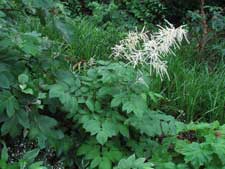Resource Library
Plant of the Week: Goatsbeard
The University of Arkansas System Division of Agriculture does not promote, support or recommend plants featured in "Plant of the Week." Please consult your local Extension office for plants suitable for your region.
Plant of the Week
Goatsbeard
Latin: Aruncus dioicus

One of my favorite late-spring bloomers for the shade garden is our native Goatsbeard, Aruncus dioicus.
Goatsbeard, also sometimes called Bride’s Feathers, is a member of the rose family found in moist woodlands of Europe, northern Asia and North America. In the United States, it’s found in the eastern deciduous forests and is especially abundant in the Appalachians and the Ozark ranges; in the West, it grows from northern California to Alaska. In the woodlands, it usually grows as randomly spaced individuals and not in large colonies.
The naming of Aruncus is in a continual state of flux with lots of names floating around. Some taxonomists separate these isolated populations as separate species, but most now consider them varieties of the same species.
Goatsbeard grows as an herbaceous perennial reaching 5 to 6 feet tall with a similar spread given enough time and good growing conditions. It has twice or thrice pinnately compound leaves reaching a foot or more in length with leaflets 2 to 3 inches long. It develops a modest display of yellow leaves in the fall.
In late spring and early summer, appear white, finger-like trusses of flowers in terminal clusters to a foot or more in length. Blooms look like those of astilbe, only larger. Aruncus is a dioecious species with male or female plants. Females have more slender and open florets and are not as show as the male plants. Male flowers also persist longer in the garden, usually providing effective display over a four-week period.
Goatsbeard is not widely grown, but it should be. Young plants, propagated either by division or seed, don’t make much of a showing in the nursery and are often bypassed by gardeners looking for more glitzy offerings.
Woodland plants such as goatsbeard should be planted in partial shade. In northern areas, gardeners can get away with growing them in full sun, but in the South, full sun conditions are usually fatal. At heart, this is a cool weather plant. They grow best in zones 4 to 7 though can be grown be grown farther north or farther south by careful site selection.
For best results plant goatsbeard in a humus rich, well drained soil that is kept moist during the summer. They are especially effective along woodland streams and water features. But if dry shade is all that’s available, they will tolerate it, but expect plants to be smaller. In good sites, space them 3 to 5 feet apart. In the perennial border, they should be used as a background plant.
Two dwarf forms are offered. Aruncus dioicus ‘Kneiffii’ is a cutleaf form producing finer stems and is somewhat smaller than the species. A. aesthusifolius, a Korean species, has ferny leaves and reaches only 3 feet in height but has a reputation for being difficult to establish in the garden.
By: Gerald Klingaman, retired
Extension Horticulturist - Ornamentals
Extension News - June 15, 2007
The University of Arkansas System Division of Agriculture does not maintain lists of retail outlets where these plants can be purchased. Please check your local nursery or other retail outlets to ask about the availability of these plants for your growing area.